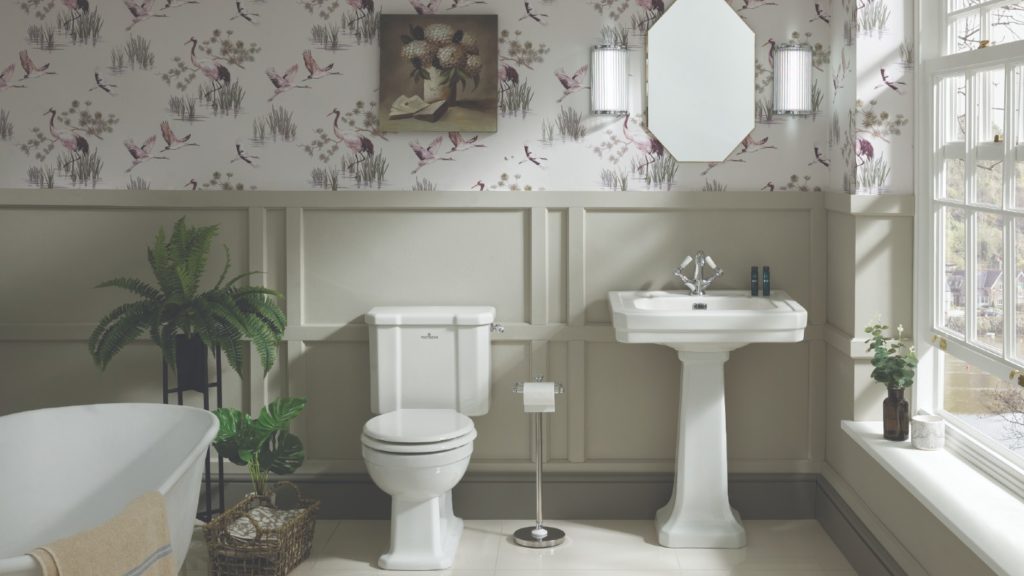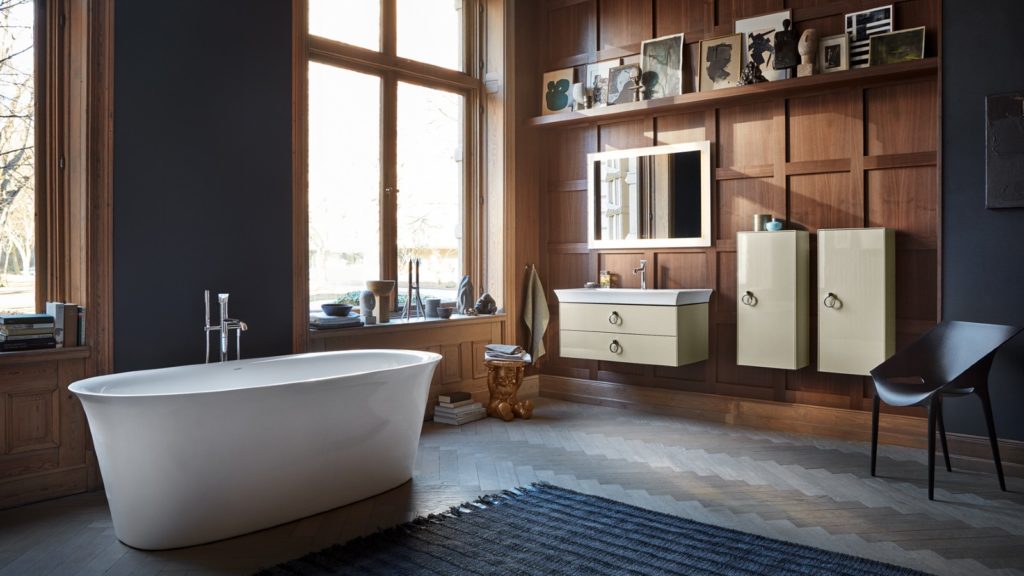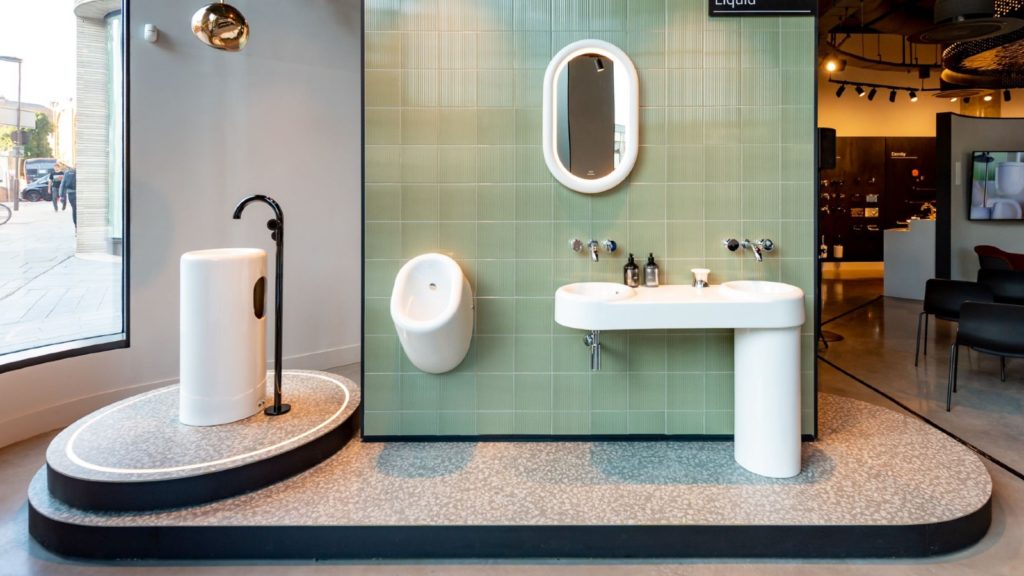We take a look at why design classics, modern design classics and value for money will become more important in the choice of bathroom suites

Part of the Bayswater Bathrooms brand is this neoclassically-designed Fitzroy suite with 650mm basin and pedestal with close-coupled WC featuring a stepped design
At a time of economic uncertainty, consumers will often look for security in their surroundings and opt for familiarity in the design of their homes.
For bathrooms, it means together with contemporary sanitaryware, there has been a move towards more classical influences.
Sponsored Video
Alongside established heritage bathroom manufacturers, Duravit and Ideal Standard have recently introduced Art Deco-inspired and neo-classical styled suites respectively.
Speaking at the launch of the White Tulip collection by Duravit, Philippe Starck said his previous collections were “extremely purist” and added “this perfection was perhaps missing a parameter – a positive nostalgia.”
Attracting millennials
Such has been the success of classically-inspired sanitaryware stying, managing director at Bayswater Bathrooms Darren Allison points to the increase of sales.

The Calla collection, designed by Ludovica and Roberto Palomba for Ideal Standard, balances classic features and contemporary touches. It has been designed to exude timeless elegance
He comments: “There has been a surge in demand for traditional sanitaryware as these pieces transcend this period and are being used heavily in transitional bathroom design.”
This blurring of modern and classical design boundaries can even be seen in the minimalistic styling of the Liquid Collection by Tom Dixon for VitrA, which has eschewed the current trends for slim designs for chubby volumes inspired by Pop Art and Victorian pipework.
It could be the reason why classical styles are attracting a younger audience, such as millennials.
Darren Allison of Bayswater Bathrooms reports: “Neo classical and Metro collections have seen a surge in popularity and what has changed is that it is the 25-35 year olds that are now buying these pieces, in comparison to the past when it was mainly the over 50s.”
Design significance
But with a move towards holistic bathroom interiors, which incorporate furniture and focal point freestanding baths, will the ceramic become less significant in design?

White Tulip is the first complete bathroom range created entirely by Philippe Starck for Duravit. It spans ceramics, furniture, bath, brassware and accessories which echo the organic silhouette of a tulip in bloom
In some bathroom designs, the pedestal has already given way to a vanity stand or undercounter storage. And if there is less design focus on sanitaryware in the bathroom, will it ultimately take less share of the overall spend in a bathroom refurbishment budget?
Managing director of Duravit UK Martin Carroll says not and explains why: “We don’t think so. The toilet is the most used item within a bathroom. Consumers still have a design requirement, whether it’s the shape of the bowl, the thickness of the seat or how it cleans – the design and overall look is very important, and we think it always will be.”
Technological impact
Reflecting the importance of sanitaryware as part of the overall bathroom space, ceramics have continued to evolve.

Influenced by Pop Art and Victorian pipework, British designer Tom Dixon created his first bathroom collection for VitrA – Liquid. It features ceramics, furniture, brassware, accessories and tiles
These include the use of lighter and more hygienic ceramic through to shorter projection basins and WCs and comfort height WCs to fit in a wider variety of projects and to be more inclusive for people with reduced movement.
Owner of Harrison Bathrooms James Harrison comments: “Sanitaryware has continued to grow and develop over the past four years.
“Rimless technology and comfort height are two major areas of growth, along with sensor touch flush systems. At Scudo, we offer a wide range of sanitaryware with open and closed back, rimless, and comfortable height.”
And classical-inspired sanitaryware designs are expected to pack as much tech punch as contemporary-style suites.
Martin Carroll of Duravit UK adds: “Technology plays a large part in the value of the bathroom, from lighting and demisting options on mirrors through to shower toilets with specific hygiene options and flush technology that is specifically designed to save water.”
Value for money
It will be these added-value features consumers will be seeking if the bathroom market starts to soften in sales.

Marcel Wanders created the New Classic bathroom collection, for Laufen, which is made from SaphiKeramik to create fine lines. It includes a variety of basins from wall-hung to countertop, furniture, washstands, rimless WCs and freestanding bath
Darren Allison comments: “The housing boom will continue to ensure that the volume of sales is there, but inflationary pressures will have an impact on the value of the sale.
“It is critical that, as a sector, we ensure value for money is safeguarded against what is going on in the wider economic environment.”
And that is equally as true for the retailer, as the consumer, as they look to protect their margin.
James Harrison of Harrison Bathrooms concludes: “The next two years will no doubt be challenging.
“However, we see the development of great service, high stock holding and increased margin opportunity as key to supporting retailers and has been, and will continue to be, the basis of our strategy for the years ahead.
“Offering higher margin opportunities allows our retailers to be more profitable and thus able to cope with the market challenges.”



